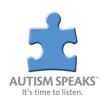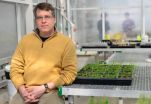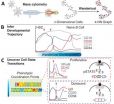(Press-News.org) A decade-long effort by members of the International Glossina Genome Initiative (IGGI) has produced the first complete genome sequence of the tsetse fly, Glossina morsitans. The blood-sucking insect is the sole transmitter of sleeping sickness, a potentially deadly disease endemic in sub-Saharan Africa. The vast store of genetic data will help researchers develop new ways to prevent the disease and provide insights into the tsetse fly's unique biology.
The tsetse fly is quite unique in the insect world: it feeds exclusively on the blood of humans and animals, gives birth to live young and provides nutrition to its young by lactation.
But in the invertebrate world, the tsetse fly is a killer: its bite can transfer the parasite that causes trypanosomiasis, or sleeping sickness. If left untreated, the disease is fatal. No vaccine has yet been developed and current drug treatments have unwanted side effects.
An estimated 70 million people throughout sub-Saharan Africa are at risk for trypanosomiasis. And because the disease also affects animals, rearing livestock in endemic areas is difficult to impossible, resulting in several billions of dollars in lost agricultural output each year. Snuffing out the tsetse fly, the disease's one and only vector, has long been a public health priority.
The IGGI researchers' goal was to identify the genes in the tsetse fly's genome that code for proteins and then to link those genes to their corresponding biological function, a process called annotation. Proteins are the 'parts list' of an organism and are involved in every aspect of its structure and function.
"In a first phase of the project, we used computers to automatically annotate the genetic sequence of the tsetse fly and compare it with the sequences of similar species with known genomes, such as the fruit fly. The computers flagged segments of genetic material in the tsetse fly's genome known to code for proteins in other species and used this data to predict the tsetse fly's gene structure and function," explains Geoffrey Attardo (Yale University), a lead author of the study. Teams of IGGI scientists then manually examined the automated annotations.
Doctoral researcher Jelle Caers and Professor Liliane Schoofs (KU Leuven) worked for two years in the IGGI group studying the tsetse fly's neuropeptide signalling genes. "We annotated 39 neuropeptide genes and 43 receptor genes. Neuropeptides regulate most if not all physiological processes including feeding, reproduction, metabolism, water balance and behaviour. In that sense, unravelling the tsetse fly's neuropeptide systems undoubtedly contributes to a better understanding of its overall biology."
And neuropeptides may just hold the key to controlling tsetse populations and eventually eradicating trypanosomiasis. "Neuropeptides are promising targets for the development of new environmentally-safe insecticides because they regulate all of the tsetse fly's crucial processes," says Jelle Caers. "Interfering with neuropeptides' proper functioning may allow us to decrease the fly's fitness and thereby shrink populations. There is still more work to be done before trypanosomiasis is eradicated in humans and animals, but decoding the tsetse genome is a big step in the right direction."
INFORMATION:
The researchers' results were published on 25 April in the journal Science.
The International Glossina Genome Initiative is an international scientific collaboration based at Yale University and involves 140 scientists worldwide.
Genetic code of the deadly tsetse fly unraveled
The blood-sucking insect is the sole transmitter of sleeping sickness
2014-04-24
ELSE PRESS RELEASES FROM THIS DATE:
Study finds accelerated soil carbon loss, increasing the rate of climate change
2014-04-24
Research published in Science today found that increased levels of carbon dioxide in the atmosphere cause soil microbes to produce more carbon dioxide, accelerating climate change.
Two Northern Arizona University researchers led the study, which challenges previous understanding about how carbon accumulates in soil. Increased levels of CO2 accelerate plant growth, which causes more absorption of CO2 through photosynthesis.
Until now, the accepted belief was that carbon is then stored in wood and soil for a long time, slowing climate change. Yet this new research suggests ...
The Ancient Maya and virtual worlds: Different perspectives on material meanings
2014-04-24
If Facebook were around 1,400 years ago, the ancient Maya might have been big fans of the virtual self.
The Maya believed that part of your identity could inhabit material objects, like a courtier's mirror or sculptor's carving tool. Maya might even name these objects, talk to them or take them to special events. They considered these items to be alive.
The practice of sharing your identity with material possessions might seem unusual in a modern context.
But is it that different from today's selfie-snapping, candy-crushing online culture, where social media profiles ...
Autism Genome Project delivers genetic discovery
2014-04-24
NEW YORK, N.Y. (April 24, 2014) – A new study from investigators with the Autism Genome Project, the world's largest research project on identifying genes associated with risk for autism, has found that the comprehensive use of copy number variant (CNV) genetic testing offers an important tool in individualized diagnosis and treatment of autism.
Funded primarily by Autism Speaks, the world's leading autism science and advocacy organization, the Autism Genome Project involved more than 50 research centers in 11 countries. The report, published today in the American Journal ...
Measles commentary in Annals of Internal Medicine
2014-04-24
1. Measles outbreaks prompt concern about physician knowledge gaps
Vaccination refusal and importation of the disease has led to increased incidence of measles in the United States. Before widespread vaccination, approximately 500,000 measles cases occurred annually, resulting in 500 deaths and 48,000 hospitalizations. Vaccination programs helped to eradicate endemic measles by the year 2000, reducing the median number of cases per year to 60. But in just the first three months of 2014, 106 measles cases were reported, prompting health officials to become concerned. Measles ...
Plants send out signals attracting harmful bacteria, MU study finds
2014-04-24
COLUMBIA, Mo. – When bacteria attack plants, they often inject harmful proteins into the host plants' cells to weaken and suppress natural defenses. However, in some plants, bacteria attack once they've recognized the plant cells as a potential host. Now, researchers at the University of Missouri have identified and replicated the process that allows the bacteria—known mostly for attacking tomatoes—to invade its host. This discovery could lead to natural anti-infective treatments that work with food-producing plants to enhance resistance to harmful bacteria in the field.
"When ...
Genome yields insights into golden eagle vision, smell
2014-04-24
WEST LAFAYETTE, Ind. - Purdue and West Virginia University researchers are the first to sequence the genome of the golden eagle, providing a bird's-eye view of eagle features that could lead to more effective conservation strategies.
Their study calls into question long-held assumptions about golden eagle vision, indicating that the raptors may not be as sensitive to ultraviolet light as previously thought. The genome also suggests that golden eagles could have a sharper sense of smell than researchers realized.
Additionally, the genome provides thousands of genetic ...
International collaboration unravels novel mechanism for neurological disorder
2014-04-24
HOUSTON – (April 24, 2014) – A team of international scientists led by Baylor College of Medicine has discovered a novel gene (CLP1) associated with a neurological disorder affecting both the peripheral and central nervous systems. Together with scientists in Vienna they show that disturbance of a very basic biological process, tRNA biogenesis, can result in cell death of neural progenitor cells. This leads to abnormal brain development and a small head circumference as well as dysfunction of peripheral nerves.
The study published today in the current issue of the journal ...
Researchers create comprehensive map of human B cell development
2014-04-24
New York, NY - In the April 24, 2014 edition of Cell, a team of researchers led by Dana Pe'er at Columbia University and Garry Nolan at Stanford University describes a powerful new method for mapping cellular development at the single cell level. By combining emerging technologies for studying single cells with a new, advanced computational algorithm, they have created the most comprehensive map ever made of human B cell development. Their approach will greatly improve researchers' ability to investigate development in cells of all types, make it possible to identify rare ...
Surprising new insights into the PTEN tumor suppressor gene
2014-04-24
BOSTON – Ever since it was first identified more than 15 years ago, the PTEN gene has been known to play an integral role in preventing the onset and progression of numerous cancers. Consequently, when PTEN is either lost or mutated, malignant cells can grow unchecked and cancer can develop.
Now a team led by investigators at Beth Israel Deaconess Medical Center (BIDMC) helps explain more precisely how PTEN exerts its anti-cancer effects and how its loss or alteration can set cells on a cancerous course. The new study, which reveals that PTEN loss and PTEN mutations are ...
Researchers pinpoint protein crucial for development of biological rhythms in mice
2014-04-24
Johns Hopkins researchers report that they have identified a protein essential to the formation of the tiny brain region in mice that coordinates sleep-wake cycles and other so-called circadian rhythms.
By disabling the gene for that key protein in test animals, the scientists were able to home in on the mechanism by which that brain region, known as the suprachiasmatic nucleus or SCN, becomes the body's master clock while the embryo is developing.
The results of their experiments, reported online April 24 in Cell Reports, are an important step toward understanding ...
LAST 30 PRESS RELEASES:
Whooping cough vaccination for pregnant women strengthens babies’ immune system
Dramatic decline in new cases of orphanhood in Uganda driven by HIV treatment and prevention programs
Stopping weight loss drugs linked to weight regain and reversal of heart health markers
Higher intake of food preservatives linked to increased cancer risk
Mass General Brigham–developed cholera vaccine completes phase 1 trial
First experimental validation of a “150-year-old chemical common sense” direct visualization of the molecular structural changes in the ultrafast anthracene [4+4] photocycloaddition reaction
Lack of support for people on weight loss drugs leaves them vulnerable to nutritional deficiencies, say experts
Dogs’ dinners can have greater climate impact than owners’
Are you ready to swap salmon for sprats and sardines?
1.6 million UK adults used weight loss drugs in past year
American College of Cardiology comments on new dietary guidelines for Americans
American Society of Gene & Cell Therapy and Orphan Therapeutics Accelerator partner to advance and commercialize promising rare disease treatments
One in 14 patients having day case surgery have new or worse chronic pain 3 months after their operation
New study highlights link between eviction rates and gun violence
Heatwaves heat up soil but not toxin levels in rice, study finds
Digital modeling reveals where construction carbon emissions really come from
Turning farm waste into water filters
New study shows how the spleen helps the immune system accept a transplant
New Mayo Clinic study advances personalized prostate cancer education with an EHR-integrated AI agent
Researchers identify novel therapeutic target to improve recovery after nerve injury
Microbes in breast milk help populate infant gut microbiomes
Reprogramming immunity to rewrite the story of Type 1 diabetes
New tool narrows the search for ideal material structures
Artificial saliva containing sugarcane protein helps protect the teeth of patients with head and neck cancer
Understanding the role of linear ubiquitination in T-tubule biogenesis
Researchers identify urban atmosphere as primary reservoir of microplastics
World’s oldest arrow poison – 60,000-year-old traces reveal early advanced hunting techniques
Bristol scientists discover early sponges were soft
New study uncovers how rice viruses manipulate plant defenses to protect insect vectors
NSF–DOE Vera C. Rubin Observatory spots record-breaking asteroid in pre-survey observations
[Press-News.org] Genetic code of the deadly tsetse fly unraveledThe blood-sucking insect is the sole transmitter of sleeping sickness






